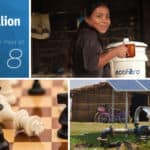Hope is the Face of Financial Inclusion: See the winners of CGAP’s 2017 photo contest
In the coastal swamps of western Bangladesh, there are few options for making a living. Three million people live on the edge of the mangrove forest, their houses on six-foot poles to protect them from rising waters, crocodiles and the Bengal tiger. For hundreds of years, honey gatherers have ventured into these forests from April to June, often crawling through dense undergrowth on their hands and knees in search of wild beehives. They carry torches of smoldering twigs and leaves to smoke out the giant bees, and with their bare hands extract the liquid gold. Sundarbans honey is prized in the cities for its medicinal qualities and sells for $2 a kilo, enough to risk the mauling from a tiger or the sting of a bee.
People in isolated regions, like the Sundarbans honey gatherers, are amongst the world’s poorest –subsisting on less than $2 a day and without financial services to help them invest and improve their lives. Digital technologies are opening up new opportunities to connect them to markets worldwide, using mobile telephones to access pricing and financial services. This year in its annual photo contest, CGAP asked photographers around the world to illustrate the economic lives of poor people and the enormous impact financial services can have in a wide range of social, economic, and developmental contexts.
Out of the 3,000 submissions from photographers in 76 countries, the three-judge panel selected Muhammad Mostafigur Rahman’s haunting photograph (pictured above) of the honey collectors in the Sundarbans wildlife sanctuary as the grand prize winner. They praised its ethereal, other-worldly quality. “It has a mythical feel to it,” said Karly Domb Sadof, a photo editor at The Washington Post and one of the judges. It also illustrates the extraordinary dangers and hardships people will endure to earn a few dollars.
“The image pulls you in. It’s immersive for the person in the image and the person viewing the image. It does a great job of making you part of that experience, ” said Indira Williams Babic, director of Photography and Visual Resources at the Newseum in Washington, D.C., also a judge.
Afriadi Hikmal, a photographer in Indonesia, captured fishermen out on the water at night, their faces lit up by the glow of their mobile phones. We also had asked photographers to depict the transformative power of digital technologies on the lives of the poor. These fishermen are studying a mobile app to guide them to the richest feeding grounds that night, an unexpected innovation that improves their productivity, bringing them more income by making their fishing trips more profitable.
Solar is another technology that is transforming lives. Manisha is a young mother who lives in the village of Lepchakha in the foothills of the Himalayas. Sujan Sarkar photographed Manisha, child on her hip, gazing confidently into the camera as she displays a small solar panel hanging from her window. It powers a single bulb that brings light into her wooden home. He called the photograph “Ray of Hope.”
Solar panels, often repaid over one or two years via mobile wallets, bring families more than electricity. They provide a tangible asset against which they can borrow to finance other capital investments or to meet emergencies, expanding a family’s opportunities. With an average daily cost of around $0.40, solar is an affordable energy source for many poor people — but not everyone. CGAP is working with providers to develop flexible financing models that allow them to bring energy profitably to more people at the base of the economic pyramid.
Opportunity shines through in the moving photograph of Sheroes Hangout, a cafe and boutique near the Taj Mahal, India, run by women who have survived acid attacks. Rather than remain victims, these women decided to open a business, which builds their confidence and provides a means to make a living, according to the photographer Sourav Karmakar. Women make up the largest share globally of the two billion people living in poverty, and they are the least likely to have access to or use financial services. The Chaanv Foundation helped the women found the café, which has a “pay as you wish” policy with contributions going directly to survivors of acid attacks in India.
The People’s Choice photograph, which received over 1,000 votes from the public, also celebrates new beginnings. La Cana Proyecto de Reinserción Social, or Social Rehabilitation Project, teaches productive skills to women in prison to help them reintegrate into Mexican society. The women Daniella Ancira photographed are knitting their way to a better future.
The CGAP photo competition, now in its 12th year, employs powerful imagery to show how poor people’s lives can be transformed when they are no longer financially marginalized and have the ability to make choices that create new opportunities. In these faces, there is dignity, hope and resilience.
“Translating the ongoing work of inclusive finance into visual form is an interesting challenge,” says judge Sarah Richardson, director and global Curator at Citi. “These photographers created compelling narratives that illustrate the profound impact of inclusive finance. Each photo tells a different story, which made reviewing the group like a trip around the globe.”
Check out the winning photos and the stories behind them in the slideshow below.
Stella Dawson is the head of communications at CGAP.
2017 CGAP Photo Contest by CGAP on Exposure
- Categories
- Agriculture, Energy, Environment, Finance, Technology



